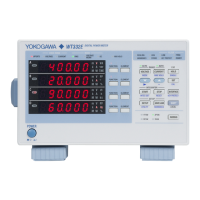App-22
IM WT310E-01EN
Example 2: Measuring 1 Arms Using the 5 A Measurement Range
Inthisexample,wemeasurethesameinputusingthe5Arange.Whenthemeasuredvalueis1.0000
[A],thereadingerrorandrangeerrorareasfollows:
• Readingerror:1.0000[A]×0.1%=0.001[A]
• Rangeerror:5[A]×0.05%=0.0025[A]
Theerrorincludedin1.0000[A]isthesumofthereadingandrangeerrors,whichis±0.0035[A].This
correspondsto0.35%ofthemeasuredvalue.
The error has increased even though the same current signal as example 1 was measured. As this
example illustrates, using a measurement range that is unnecessarily large for an input signal results
in larger measurement errors. It is import to measure using a measurement range that is appropriate
for the input signal.
Note
If the input signal is not a sine wave and includes distortions and spikes, select a somewhat large
measurement range that would not cause peak over-ranges to occur.
Example 3: Measuring 0.5 Arms Using the 1 A Measurement
Range
Next,wemeasure0.5Ausingthe1Ameasurementrange(thesameasexample1).Whenthe
measuredvalueis0.5000[A],thereadingerrorandrangeerrorareasfollows:
• Readingerror:0.5000[A]×0.1%=0.0005[A]
• Rangeerror:1[A]×0.05%=0.0005[A]
Theerrorincludedin0.5000[A]isthesumofthereadingandrangeerrors,whichis±0.001[A].This
correspondsto0.2%ofthemeasuredvalue.
When we compare this result with that of example 1, we notice the following:
• Thereadingerrorhasbeenreducedinaccordancewiththeinputamplitude.
• Therangeerrorhasnotchanged.
Asaresult,theerroris0.2%,whichisslightlylargerthan0.15%ofexample1.Thisisalsobecause
themeasurementrangeislargerelativetotheinputsignal.Inthiscase,weshouldusethe0.5A
measurement range.
Measurement Error of Active Power
Onthisinstrument,thepoweraccuracyintherangeof45Hzto66Hzis±(0.1%ofreading+0.05%
of range).
Let us calculate the error for the following example.
• Voltagemeasurementrange:150V,measuredvoltage:100.00V
• Currentmeasurementrange:1A,measuredcurrent:0.800A
• Measuredpower:80.00W
• 60Hzsinewaveforbothvoltageandcurrent
• Phasedifferencebetweenthevoltageandcurrentsignals=0°
Power Range
The power measurement range is defined as voltage measurement range × current measurement
range.Inthisexample,thepowermeasurementrangeis150V×1A=150W.Weusethispower
measurement range to calculate the range error.
Thereadingerrorandrangeerrorincludedinthemeasuredpower(80.00W)areasfollows:
• Readingerror:80.00[W]×0.1%=0.08[W]
• Rangeerror:150[W]×0.05%=0.075[W]
Theerrorincludedin80.00[W]isthesumofthereadingandrangeerrors,whichis±0.155[W].This
correspondsto0.19375%ofthedisplayedvalue.
Appendix 5 Measurement Accuracy and Measurement Error

